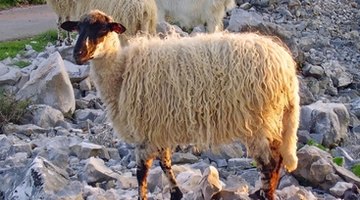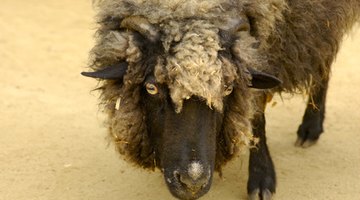Traditionally wool has been used to knit sweaters, gloves, scarves, long johns and tweed jackets. Wool pads were used as oven gloves -- their insulating properties blocking heat transfer from cooking equipment. A good sound insulator, wool felt was used to cover billiard tables and the traditional "green baize door" between a household and the noisy servants' quarters. Wool carpets keep our feet warm and reduce energy loss from the home. The reasons wool insulates well relate to its structure.
Electron arrangement
Essentially, substances are good insulators because they are poor conductors. They do not transmit heat away from a warm object, instead trapping heat around it. Because heat, electricity and sound are all forms of energy, substances that are good heat insulators are usually good electrical and sound insulators. The reason relates to materials' atomic structure. Where the electrons in the outer level of an atom are mobile – as in many metals – they transfer energy as they move about. Where electrons in an atom are tightly bound together without much freedom of movement, they cannot easily transmit energy.
- Essentially, substances are good insulators because they are poor conductors.
- Where electrons in an atom are tightly bound together without much freedom of movement, they cannot easily transmit energy.
Dual fibre types

Animal hair of all types exists to insulate the animal. Sheep live outdoors, often in an inhospitable environment. They must endure cold weather and precipitation while maintaining a warm core body temperature. Their fleece is thick, giving substantial protection against rain, wind and snow. A sheep's fleece consists of a double layer of different types of fibres. A soft, fine inner layer traps heat next to the skin. A coarser, oily outer coat of longer fibres protects against bad weather.
- Animal hair of all types exists to insulate the animal.
- Their fleece is thick, giving substantial protection against rain, wind and snow.
Air spaces

Wool's stranded structure, crimped profile and springy, curling form help trap air between the strands. Additionally each strand is a hollow fibre, with air at its core. Air is a good insulator. This is because heat cannot be conducted through a void, only by contact between moving electrons. Air molecules are wide apart with spaces between them, inhibiting conduction. By trapping air against the skin, wool increases its integral insulating properties. The air spaces also mean wool is “breathable” and “moisture wicking” – moisture from sweat can escape into the central core of the wool fibres, avoiding the wearer becoming cold and clammy. According to Sierra Trading Company, a wool fibre's core can absorb 30 per cent of its own weight in moisture vapour, without becoming clammy.
- Wool's stranded structure, crimped profile and springy, curling form help trap air between the strands.
- According to Sierra Trading Company, a wool fibre's core can absorb 30 per cent of its own weight in moisture vapour, without becoming clammy.
Oil content
Wool's insulating properties are enhanced by its oil content. The outer layer of a sheep's fleece feels greasy. This natural oil, called lanolin, repels water, ensuring that even in wet or snowy weather, the sheep stays dry. This is important because being wet exacerbates the effects of cold -- water is a good conductor. Additionally, a sodden fleece would cling to the animal, eliminating the air spaces found in a dry fleece.
- Wool's insulating properties are enhanced by its oil content.
- Additionally, a sodden fleece would cling to the animal, eliminating the air spaces found in a dry fleece.
Cutting-edge uses for wool
Increasingly wool is being promoted as loft insulation. Wool is a renewable resource. It is less irritating and has none of the health risks associated with fibreglass insulation. It is also fire-retardant and recyclable.
- Increasingly wool is being promoted as loft insulation.
- It is also fire-retardant and recyclable.
